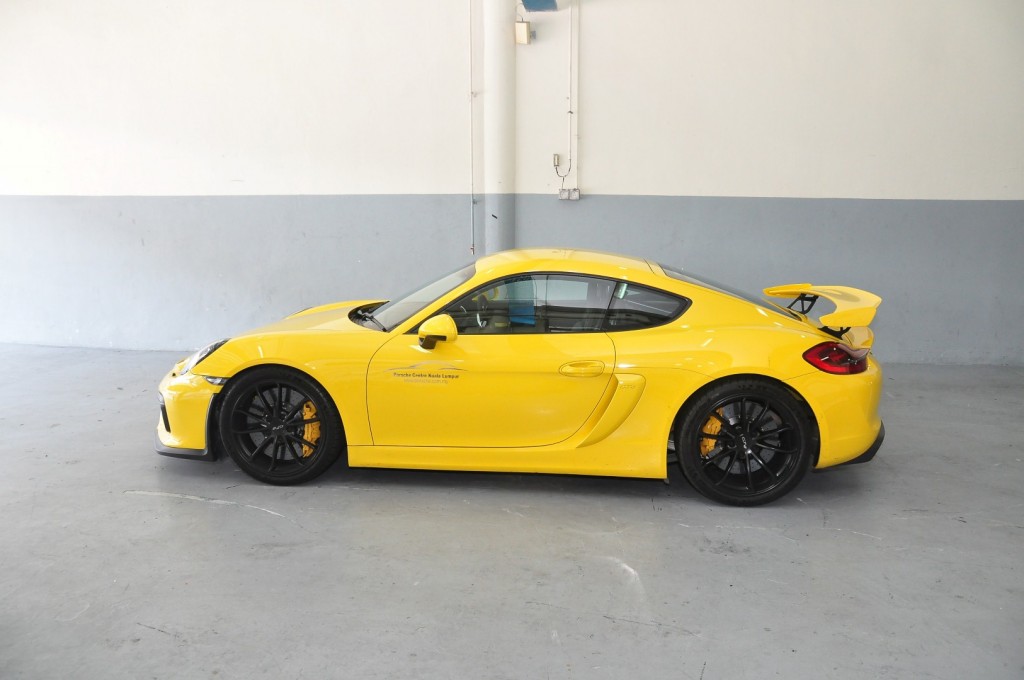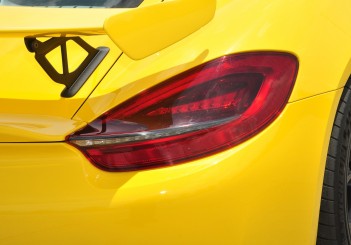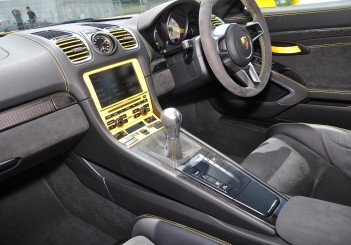We find ourselves at the Sepang International Circuit getting ready to have a go in this visually captivating Porsche that has come into existence after having borrowed from the parts-bin of the company’s favoured 911 family – the Carrera S, GT3 and even the 918 Spyder.

The GT-wing, made of carbon fibre reinforced polymer (CFRP), is prominent at the rear and with the capability of lapping the infamous Nürburgring Nordschleife in 7 minutes and 40 seconds; it was hard to hold back the enthusiasm.
Priced from RM840,000, the Cayman GT4 uses the same engine found in the Carrera S, only its 3.8-litre naturally aspirated flat-six engine that’s been turned 180 degrees just to accommodate the exhaust and fuel feed and then mated to a six-speed manual transmission for some three-pedal fun.
The throaty engine feels free and willing to rev up towards its 7,800rpm redline, ever wanting to unleash all its 385hp at 7,400rpm and 420Nm of torque from 4,750 to 6,000rpm that’s sent to the rear wheels to help it reach 100kph from standstill in 4.4 seconds before topping out at 295kph.

Furthermore, the seats have been upgraded to the one-piece (fixed-back) bucket seats with exposed carbon weave finish adopted from the 918 Spyder and upholstered in black leather and Alcantara centre – allowing the matching body colour stitches and GT4 logo to stand out.
To heighten the fun, it also came with a set of optional cross-drilled Porsche Ceramic Composite Brakes (PCCB) 410mm-front and 390mm-rear and matched with yellow aluminium six-pot (front) and four pot (rear) callipers – which is the same upgrade set up used in the 911 GT3.

A quick thumbs-up from the “gate-keeper” and it would be a full-throttle experience down the straight towards turn one and two as we revelled in the engine’s sonorous notes.
The stiff bucket seats not only kept us properly in place, but also allowed us to tell how much the car was yawing via our posterior.
In short, there’s plenty of information reaching the driver from the get go, from each of the wheels’ traction to how the car’s 1,340kg of unladen heft transfers from aft to fore under heavy braking, abrupt accelerations and heading into corners.

And to help manage the tyres, the car was also installed with an optional tyre pressure monitoring system that shows (in real-time) the pounds per square inch (PSI) for each tyre.
We found that even with the track’s surface temperature approaching the 50-degree Celsius mark, the 245/35 (front) and 295/30 (rear) Michelin Pilot Sport Cup 2 tyres on 20-inch wheels didn’t lose too much of its performance.

Porsche Cayman GT4 (left) overtaking a 911
Under hard braking, there’s never a slippery situation – even with Monsieur Bibendum (Michelin Man) probably at its melting point.
While still on our hot laps, the car’s electronic driving aids were still engaged and lacked any form of intrusion, but still allowed for some tyre slippage to occur that was just enough for a good level of driver engagement.
As for old-school track goers who revel in the use of all three-pedals and take pride in their skills of left-foot braking and heel-and-toe techniques, the Cayman GT4 simplifies everything to help maximise attention on driving the car and shifting the gears instead of worrying about the “foot-work” all the time.

The Porsche Torque Vectoring (PTV) system, which uses a mechanical differential lock, coupled with the never-wants-to-fade PCCB brakes ensures that the front and rear are kept very well in check.
At times we may lock one of the front wheels momentarily, but the anti-lock braking system is quick to release it and ensure optimal braking is provided without destabilising the car all too much.

Upon exiting a left corner, we admit that we were a little overzealous and gunned the throttle a little early.
This caused the rear-end to step out, but thanks to Porsche’s Electronic Stability Control and Traction Control (ESC+TC), it was a gradual step that was quickly caught and mooted by a short and quick right flick of the nicely weighted electromechanical power steering.

Which means, so long as there’s still strength in the arms, plenty of tyres to go around and enough fuel to keep the high-compression (12.5:1) aluminium flat-six engine running, there really isn’t any good reason to stop... maybe just till dinner time.













































































